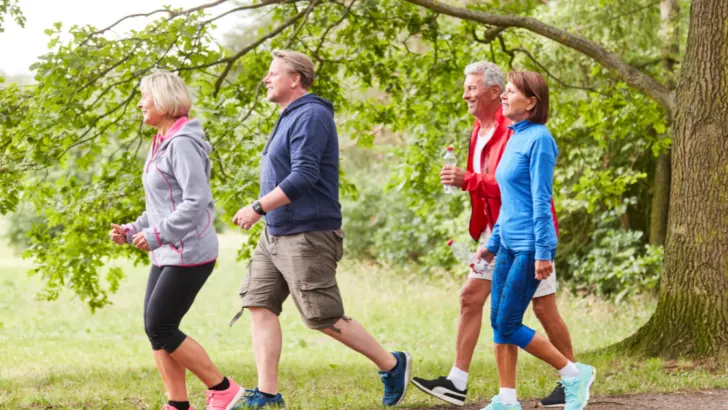Hiking is a popular outdoor activity that provides numerous benefits for physical and mental health. However, there is a debate about whether hiking every day is good or bad for you. I have researched this topic and found that the answer is not straightforward. It depends on various factors such as your fitness level, hiking intensity and duration, and recovery time.

On the one hand, hiking every day can be an excellent way to stay active and improve your cardiovascular health, strength, and endurance. It can also help you lose weight, reduce stress, and boost your mood. However, on the other hand, hiking every day can also lead to overtraining, injuries, and burnout if you don’t listen to your body’s signals and take breaks when you need them. Therefore, it’s essential to find the right balance between the benefits and risks of hiking every day to avoid harming your health and well-being.
Key Takeaways
- Hiking every day can be beneficial for your health, but it can also lead to overtraining and injuries if you don’t listen to your body’s signals and take breaks when you need them.
- The ideal intensity and duration of hikes for avoiding overtraining depend on your fitness level and goals, and you should gradually increase the distance and intensity of your hikes over time.
- To recover from overtraining, you should take rest days, drink plenty of water, eat a healthy diet, and listen to your body’s signals.
Is Hiking Everyday Bad?
As someone who loves hiking and tries to do it as often as possible, I’ve often wondered if hiking every day is bad for me. After doing some research, I’ve found that the answer is no, hiking every day is not bad for you. In fact, it can be quite beneficial for your physical and mental health.
Hiking is a low-impact exercise that can help improve cardiovascular health, strengthen muscles, and increase bone density. It can also help reduce stress and anxiety and improve overall mood. However, it’s important to listen to your body and not push yourself too hard. If you’re feeling tired or sore, take a break and rest.

One thing to keep in mind is that hiking every day can put you at risk for overuse injuries, such as shin splints or plantar fasciitis. To prevent these types of injuries, it’s important to wear proper footwear and gradually increase the intensity and duration of your hikes.
Overall, hiking every day can be a great way to stay active and improve your health, as long as you’re careful and listen to your body.
Related Posts:
Benefits of Hiking Everyday
Hiking is not only an enjoyable outdoor activity, but it also has numerous physical and mental health benefits. Here are some of the benefits of hiking every day.
Improved Physical Fitness
Hiking is a great way to improve your physical fitness. It is a low-impact exercise that can help strengthen your muscles, especially in your legs, hips, and core. Hiking on a regular basis can also improve your cardiovascular health, lower your blood pressure, and reduce your risk of heart disease.

Reduced Stress
Spending time in nature and getting some exercise can help reduce stress and anxiety. Hiking can be a great way to disconnect from technology and the stress of daily life and connect with nature. The fresh air, scenic views, and peaceful surroundings can help you relax and reduce your stress levels.
Weight Loss
Hiking can also help with weight loss. It is a great way to burn calories and lose weight, especially if you hike at a moderate to vigorous intensity. Hiking can also help you maintain a healthy weight and improve your overall body composition.
Increased Energy Levels
Hiking can also boost your energy levels. It can help improve your circulation, increase your oxygen intake, and release endorphins, which can all contribute to increased energy levels. Hiking can also help you get a better night’s sleep, which can also improve your energy levels during the day.

Improved Sleep
Hiking can help improve your sleep quality and duration. Spending time in nature and getting some exercise can help regulate your sleep-wake cycle and improve your sleep quality. Hiking can also help reduce stress and anxiety, which can interfere with sleep.
Related Posts:
Risks of Hiking Every day
Hiking every day can be an excellent way to stay active and improve your overall health. However, there are some risks associated with hiking too often. In this section, I will discuss the potential risks of hiking every day and how to mitigate them.
Overtraining
One of the biggest risks associated with hiking every day is overtraining. Overtraining occurs when you push your body too hard without giving it enough time to rest and recover. This can lead to a variety of negative health effects, including fatigue, muscle soreness, and decreased immune function.
To avoid overtraining, it’s important to give your body enough time to rest and recover between hikes. This might mean taking a day off between hikes or alternating between high-intensity and low-intensity hikes.
Injuries
Another risk associated with hiking every day is the risk of injury. Hiking puts a lot of stress on your joints and muscles, which can lead to injuries like sprains, strains, and fractures.

To reduce your risk of injury, it’s important to wear appropriate footwear and clothing, warm up before each hike, and gradually increase the intensity and duration of your hikes over time.
Heat Exhaustion
Hiking every day in hot weather can also increase your risk of heat exhaustion. Heat exhaustion occurs when your body overheats and is unable to cool itself down. Symptoms of heat exhaustion include dizziness, nausea, and fatigue.
To avoid heat exhaustion, it’s important to stay hydrated, wear lightweight and breathable clothing, and take frequent breaks in the shade.
Altitude Sickness
If you’re hiking at high altitudes, there’s also a risk of altitude sickness. Altitude sickness occurs when your body doesn’t get enough oxygen at high altitudes, which can lead to symptoms like headaches, nausea, and dizziness.
To avoid altitude sickness, it’s important to acclimate to high altitudes slowly and stay hydrated. If you experience symptoms of altitude sickness, it’s important to descend to a lower altitude as soon as possible.

Related Posts:
The Specific Amount of Hiking That Is Considered Too Much for Different Fitness Levels
When it comes to hiking, the amount that is considered too much varies depending on an individual’s fitness level. While hiking every day can offer numerous health benefits, it is important to know your limits and gradually increase the intensity and duration of your hikes.
As someone who has been hiking regularly for years, I have found that the following guidelines can be helpful in determining how much hiking is too much for different fitness levels:
Beginners
For those who are new to hiking or have a low level of fitness, it is best to start with short, easy hikes and gradually increase the distance and elevation gain over time. A good starting point would be to aim for a 1-2 mile hike with minimal elevation gain, and then gradually increase the distance and elevation gain as your fitness level improves.
Intermediate Hikers
Intermediate hikers who have a moderate level of fitness can handle longer hikes with more elevation gain. A good goal for intermediate hikers would be to aim for a 5-10 mile hike with less than 2,000 feet of elevation gain. It is important to listen to your body and take breaks as needed to avoid overexertion.

Advanced Hikers
For advanced hikers with a high level of fitness, longer and more challenging hikes are possible. These hikers can handle hikes of 10 miles or more, and those with more than a 2,000-foot elevation gain. However, it is still important to gradually increase the intensity and duration of your hikes to avoid injury.
In summary, the amount of hiking that is considered too much varies depending on your fitness level. Beginners should start with short, easy hikes and gradually increase the intensity over time. Intermediate hikers can handle longer hikes with more elevation gain, while advanced hikers can tackle longer and more challenging hikes. Regardless of your fitness level, it is important to listen to your body and avoid overexertion.
The Ideal Intensity and Duration of Hikes for Avoiding Overtraining
As someone who has hiked every day for a month, I can attest to the importance of finding the right intensity and duration for your hikes to avoid overtraining. Overtraining can lead to fatigue, injury, and burnout, which can ultimately hinder your progress and enjoyment of hiking.
To avoid overtraining, it’s important to find a balance between intensity and duration. Hiking at a moderate intensity for a longer duration can be just as effective as hiking at a high intensity for a shorter duration. It’s important to listen to your body and adjust your intensity and duration accordingly.
To help guide you in finding the ideal intensity and duration for your hikes, consider the following:
Intensity
When it comes to intensity, it’s important to find a level that challenges you without pushing you to your limits. This will vary depending on your fitness level and experience with hiking. As a general rule of thumb, you should aim to hike at a pace that allows you to maintain a conversation without feeling out of breath.

Duration
The duration of your hikes will depend on your fitness level and goals. As a beginner, you may want to start with shorter hikes and gradually increase the duration as your fitness improves. As a general guideline, aim for at least 30 minutes of hiking per day, gradually increasing to 60-90 minutes per day as your fitness improves.
Recovery
Recovery is just as important as the hike itself. Make sure to incorporate rest days into your hiking routine to allow your body to recover and prevent overtraining. Additionally, make sure to stretch before and after your hikes to prevent injury and improve flexibility.

In summary, finding the ideal intensity and duration for your hikes can help prevent overtraining and ensure that you continue to enjoy the benefits of hiking without experiencing fatigue or burnout.
Tips for Recovering from Overtraining
As someone who loves hiking, it can be easy to get carried away and overdo it. Overtraining can lead to fatigue, injury, and decreased performance. If you find yourself experiencing symptoms of overtraining, it’s important to take a break and focus on recovery. Here are some tips for recovering from overtraining:
- Rest: The most important thing you can do for your body when you’re experiencing symptoms of overtraining is to rest. Take a break from hiking and allow your body to recover. This may mean taking a few days off or even a week or more, depending on the severity of your symptoms.
- Nutrition: Proper nutrition is essential for recovery. Make sure you’re getting enough calories and nutrients to support your body’s needs. This may mean increasing your intake of protein, carbohydrates, and healthy fats.
- Hydration: Staying hydrated is also important for recovery. Make sure you’re drinking enough water and electrolyte-rich fluids to replenish what you’ve lost during your hikes.
- Sleep: Sleep is when your body does most of its repair work. Make sure you’re getting enough sleep each night to support your recovery. Aim for at least 7-8 hours of sleep per night.
- Cross-training: While taking a break from hiking, consider incorporating other types of exercise into your routine. This can help prevent boredom and keep you active while allowing your body to recover.

Remember, recovery is just as important as training. Take the time to rest and recover when you need it to avoid overtraining and stay healthy and strong on the trails.
Related Posts:
Listen to Your Body and Take Breaks When You Need Them
As someone who hikes regularly, I know how important it is to listen to my body and take breaks when I need them. Hiking every day can be a great way to stay active and healthy, but it’s important to pay attention to your body’s signals and take rest days when necessary.
When you’re hiking, your body is working hard to keep you moving. It’s important to pay attention to any signals your body is sending you that it needs a break. This could be feeling tired, experiencing muscle pain or soreness, or feeling short of breath. If you ignore these signals and push yourself too hard, you could end up causing an injury or burnout.
Taking breaks when you need them doesn’t mean you’re weak or not fit enough to handle the hike. It’s actually a sign of strength and self-awareness to recognize when your body needs rest. I always make sure to take frequent breaks during my hikes, especially on longer or more challenging trails.

During your breaks, make sure to hydrate and refuel your body with snacks or a meal. This will help keep your energy levels up and prevent fatigue. I also like to use my breaks as an opportunity to take in the beautiful scenery around me and appreciate the nature I’m surrounded by.
In summary, listening to your body and taking breaks when you need them is crucial when hiking every day. It’s important to recognize when your body needs rest and not push yourself too hard. By taking breaks and refueling your body, you’ll be able to continue hiking and enjoying the outdoors for years to come.
Gradually Increase the Distance and Intensity of Your Hikes over Time
As someone who enjoys hiking every day, it’s important to remember that gradually increasing the distance and intensity of your hikes over time can help you avoid injury and improve your overall fitness level.
Starting with shorter, easier hikes and gradually increasing the distance and elevation gain can help your body adjust to the physical demands of hiking. It’s also important to listen to your body and take rest days when needed to allow your muscles to recover.
One way to gradually increase the intensity of your hikes is to add weight to your backpack. Start with a light load and gradually increase the weight over time to build strength and endurance.

Another way to increase the intensity of your hikes is to incorporate interval training. This can involve alternating between periods of fast-paced hiking and slower, more relaxed hiking to help improve cardiovascular fitness.
It’s important to remember that hiking every day is a personal choice, and it’s important to listen to your body and adjust your routine as needed. Gradually increasing the distance and intensity of your hikes over time can help you achieve your fitness goals while minimizing the risk of injury.
Be Sure to Drink Plenty of Water and Eat a Healthy Diet
As someone who hikes every day, I know firsthand the importance of staying hydrated and fueling my body with the right nutrients. It can be tempting to skip meals or rely on junk food when you’re out on the trails, but that’s a surefire way to feel sluggish and lethargic.
To avoid this, I make sure to drink plenty of water throughout the day. Mayo Clinic recommends that women drink at least 11.5 cups (92 ounces) of fluids per day, while men should aim for at least 15.5 cups (124 ounces) of fluids per day. This includes fluids from water, other beverages, and food. I always bring a water bottle with me on my hikes and make sure to take sips regularly, even if I don’t feel thirsty.

In addition to water, it’s important to eat a healthy diet that provides your body with the fuel it needs to keep going. That means plenty of fruits and vegetables, whole grains, lean protein sources, and healthy fats. I like to pack snacks like trail mix, fresh fruit, and energy bars to keep me going on longer hikes.
It’s also important to pay attention to your body’s signals and adjust your intake accordingly. If you’re feeling thirsty, take a break and drink some water. If you’re feeling hungry, have a snack. And if you’re feeling tired or lightheaded, it may be a sign that you need to eat or drink more.
By staying hydrated and fueling your body with the right nutrients, you’ll be able to enjoy your daily hikes to the fullest and feel your best both on and off the trails.
Take Rest Days Between Hikes
As someone who enjoys hiking, I understand the desire to hit the trails every day. However, it’s important to take rest days between hikes to allow your body to recover and prevent injuries.
Rest days don’t necessarily mean sitting on the couch all day. You can still engage in low-impact activities like yoga or swimming to keep your body moving without putting too much strain on your muscles and joints. It’s also important to stay hydrated and eat a balanced diet to support your body’s recovery.

According to Backpacking Light, taking rest breaks during hikes can also be beneficial. For example, hiking for 45 minutes and then resting for 15 minutes can help you recharge and prevent burnout. Experiment with different rest intervals to find what works best for you and your body.
In addition to physical benefits, taking rest days can also improve your mental health. Hiking every day can become monotonous and lead to burnout. Taking a break can help you appreciate the beauty of nature and restore your motivation to hit the trails.
Overall, while hiking every day may seem tempting, it’s important to prioritize rest days to prevent injuries and maintain your physical and mental health.
Conclusion
Based on the research and my own experience, I believe that hiking every day can be both beneficial and potentially harmful, depending on how you approach it.
On the one hand, hiking every day can provide numerous physical and mental health benefits, including improved cardiovascular health, reduced stress and anxiety, and increased strength and endurance. Additionally, hiking can be a great way to explore nature, connect with others, and challenge yourself.

However, it’s important to be mindful of your body’s limits and to take steps to prevent injury and burnout. Overtraining can lead to a variety of negative effects, including muscle soreness, fatigue, and decreased immune function. It’s crucial to listen to your body and adjust your hiking routine as needed.
Overall, I believe that hiking every day can be a great way to improve your health and well-being, as long as you approach it with caution and respect for your body’s needs. By staying mindful and taking care of yourself, you can reap the many benefits of this rewarding activity.
Frequently Asked Questions
What are the benefits of taking rest days in between hikes?
Rest days are essential for allowing your body to recover from the physical exertion of hiking. They give your muscles time to repair and rebuild, which can help prevent injury and improve overall performance. Rest days also give you a chance to mentally recharge, which can be just as important as physical recovery.
Is it safe to hike every day?
Hiking every day can be safe as long as you take the necessary precautions to prevent injury and overexertion. It’s important to gradually increase the intensity and duration of your hikes to allow your body to adapt. It’s also important to listen to your body and take rest days when needed.
How can I prevent injury if I hike frequently?
To prevent injury when hiking frequently, it’s important to wear appropriate footwear and clothing, stay hydrated, and stretch before and after your hikes. It’s also important to gradually increase the intensity and duration of your hikes to allow your body to adapt. If you experience pain or discomfort during a hike, stop and rest or seek medical attention if necessary.
What are some signs that I may be overdoing it with hiking?
Signs that you may be overdoing it with hiking include persistent pain or discomfort, fatigue, decreased performance, and decreased motivation. It’s important to listen to your body and take rest days when needed to prevent overexertion and injury.
What is the recommended frequency for hiking to see health benefits?
The recommended frequency for hiking to see health benefits varies depending on your fitness level and goals. However, as a general guideline, aim to hike at least 2-3 times per week for at least 30 minutes at a moderate intensity.
Can hiking every day lead to burnout or fatigue?
Hiking every day can lead to burnout or fatigue if you don’t allow your body to rest and recover. It’s important to listen to your body and take rest days when needed to prevent overexertion and burnout. It’s also important to vary your hiking routine to prevent boredom and maintain motivation.
